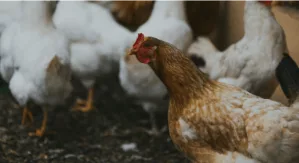Antibiotic resistance refers to bacteria that have evolved to the point that they are not easily killed by antibiotics. Antibiotic resistance is a serious public health concern and the animal health community shares that concern.
Antibiotic Use in Animals
Science doesn’t provide a clear answer to that question, but researchers are working to better understand resistance. Although there is scientific acknowledgement that the use of antibiotics in people is the primary driver of human antibiotic resistance, Phibro Animal Health Corporation recognizes that antibiotics must be used responsibly in food animals to minimize agriculture’s contribution to antibiotic resistance. That’s why the animal health community worked with the Food and Drug Administration (FDA) and the American Veterinary Medical Association (AVMA) to change the way antibiotics are used in livestock and poultry. Changes that took effect in January 2017 in the United States limit the use of antibiotics in animal agriculture and increase oversight by veterinarians.
A study of macrolides concludes there is a 1 in 10 million to 1 in 3 billion chance of treatment failure from antibiotic resistance related to the use of common animal antibiotics, depending upon the bacteria. To put that into context, you are far more likely to die from a dog bite or lightning strike than from treatment failure related to the use of antibiotics in animals.
Sources:
- Public health consequences of macrolide use in food animals: a deterministic risk assessment.
- National Safety Council: Risk of dying from a dog bite is 1:116,448 and from lightning strike is 1:164,968.
A comprehensive 2016 review of 50 studies published in Critical Reviews in Food Science and Nutrition concluded there is an established connection between animal antibiotic use and antibiotic resistance in animals, but no established causal relationship between animal antibiotic use and human resistance related to campylobacter.
Source:
“Effect of Antimicrobial Use in Agricultural Animals on Drug-resistant Foodborne Campylobacteriosis in Humans: A Systematic Literature Review,” M.A. McCrackin, Kristi L. Helke, Ashley M. Galloway, Ann Z. Poole, Cassandra D. Salgado & Bernadette p. Marriott, Critical Reviews in Food Science and Nutrition, Volume 56, 2016 – Issue 13, Pages 2115-2132.
Antibiotic residue is different from resistance and refers to molecules that remain in meat from animals that have been treated with antibiotics. There are multiple safeguards in place to ensure meat is safe, including mandatory antibiotic withdrawal periods for animals and routine testing of meat by the U.S. Department of Agriculture and food companies. Antibiotic residue is not the same as antibiotic resistance.
The Centers for Disease Control (CDC) issued a 2013 study on the most concerning antibiotic resistance threats and none of the most urgent threats have any relation to farm animals. On the broader CDC list, which includes less urgent threats, only two of 18 involve bacteria associated with farm animals.
Although there are many unanswered questions about the cause of antibiotic resistance, the animal health community recognizes that antibiotics must be used responsibly when treating animals to minimize agriculture’s contribution to antibiotic resistance.
A report by the Centers for Disease Control (CDC) sheds some light on the matter. The CDC identified the most concerning public health threats from antibiotic resistant bacteria. None of the most urgent threats have any relation to farm animals. On the broader CDC list, which includes less urgent threats, only two of 18 involve bacteria associated with farm animals.
It’s important to better understand the impacts of all uses of antibiotics on resistance so effective strategies can be developed to protect public health, food safety and animal well-being.
Affordability and Sustainability & Antibiotics and Food Safety
Cooking meat to the proper temperature kills all bacteria, eliminating the possibility of exposure to resistant bacteria. It is also important to handle raw meat properly to prevent spreading bacteria to other foods.
The responsible use of animal antibiotics benefits all of us by making food safer and more affordable. Antibiotics make food safer by helping keep animals healthy, and studies show this reduces bacteria entering the food supply. Keeping animals healthy allows farmers to produce food more effectively, which has the added benefit of making food more affordable while using fewer natural resources.
The responsible use of antibiotics helps keep animals healthy, which is better for the environment. When left untreated, sick animals grow more slowly, requiring more food and water. Thus, more grain must be grown for feed, which requires more fertilizer, water and farmland. So, sick animals have a larger environmental impact, while healthy animals use fewer natural resources. Practices that allow us to treat sick animals, resulting in the use of fewer natural resources, are good for the environment and good for everybody.
Antibiotics and Animal Welfare
Antibiotics have been used in farm animals for decades for the same reason they’re used in humans – to treat or prevent or control diseases that cause pain and suffering. When an animal is sick with a bacterial infection, treating it with antibiotics is the ethical thing to do. The American Veterinary Medical Association, the nation’s largest veterinarian organization, testified before Congress that antibiotics are one of the most important tools that veterinarians use to protect both human health and animal health.
Animal suffering could be an unintended consequence if antibiotics used in human medicine are completely disallowed in animals. In addressing the issue of reducing antibiotic use in poultry, an official with the American Society for the Prevention of Cruelty to Animals (ASPCA) said, “If animal welfare is not addressed in conjunction with pulling back the drugs, this could actually be a very dangerous move for birds and ultimately for consumers.”
Veterinarians and farmers recognize that diseases can spread rapidly, so when one animal shows symptoms of a disease or becomes ill, the animals around it are likely to get sick and may die if they aren’t treated. This is known as preventive antibiotic treatment.
Historically, antibiotics have also been used in animals to encourage growth. But with a change adopted by the animal health community Jan. 1, 2017, antibiotics important to human medicine are used only for treatment, control and prevention of disease in animals – not growth promotion.
Farmers have many choices in how they raise animals, just as companies that produce and sell food have different marketing options. The animal health community supports consumer choice, as long as it does not endanger animal health or negatively impact food safety.
The animal health community, including Phibro, worked with the Food and Drug Administration to further ensure the responsible use of antibiotics in animals, resulting in several changes that took effect Jan. 1, 2017. Now, antibiotics important to human medicine are used only for treatment and prevention of disease in animals – not growth promotion. We also increased veterinarian oversight of agricultural antibiotic use. A veterinary feed directive (VFD) – essentially a prescription from a veterinarian – is now required to treat animals with antibiotics that are also used in human medicine.
Animal health companies are continually working to develop new ways to protect and improve animal health. For example, a nutritional supplement developed from natural, sustainable compounds helps to bolster animals’ immune systems, which may reduce the need for animal antibiotic use in the future. There are also new vaccines being developed. For example, one vaccine could potentially reduce the risk of salmonella and E. coli contamination in poultry meat and eggs. This helps protect both animal and human health, and may also reduce the need for animal antibiotic use in the future.


